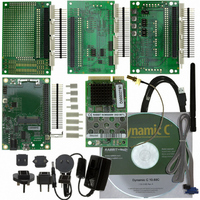101-1285 Rabbit Semiconductor, 101-1285 Datasheet - Page 65

101-1285
Manufacturer Part Number
101-1285
Description
DEV KIT DELUXE MINICORE RCM5600W
Manufacturer
Rabbit Semiconductor
Series
MiniCore™r
Type
Transceiver, 802.11 b/gr
Datasheet
1.101-1285.pdf
(130 pages)
Specifications of 101-1285
Frequency
2.4GHz
Processor To Be Evaluated
Rabbit 5000
Processor Series
RCM5600W
Interface Type
RS-232, USB, PCI
Maximum Operating Temperature
+ 55 C
Minimum Operating Temperature
- 30 C
Operating Supply Voltage
3.15 V to 3.45 V
Silicon Manufacturer
Rabbit Semiconductor
Silicon Family Name
RabbitCore
Kit Contents
Board
Features
On-board Single-Chip 802.11b/g Transceiver, Built-In Web Server
Development Tool Type
Hardware /
Rohs Compliant
Yes
For Use With/related Products
RCM5600W
Lead Free Status / RoHS Status
Not applicable / Not applicable
Other names
316-1161
6.2.4.2 Wi-Fi Operation
•
•
OEM User’s Manual
Before you compile and run this sample program, check the TCP/IP configuration
parameters, the IP address, and the SSID in the macros, which are reproduced below.
Now compile and run this sample program. Uncomment the
VERBOSE
window will then display a menu that allows you to complete the configuration of the
user interface.
WIFIDHCPORTSTATIC.C
tion or DHCP. The
ples of using DHCP with your application.
Before you compile and run this sample program, check the TCP/IP configuration
parameters, the IP address, and the SSID in the macros, which are reproduced below.
Modify the values to match your network. You may also need to modify the values for
MY_GATEWAY
Now press
STDIO
WIFIMULTIPLEAPS.C
will need two access points to run this sample program. The access points should be
isolated or on separate networks.
The sample program associates the RabbitCore or MiniCore module with the first access
point (
the sample program waits for a predefined time period, and then pings the Ethernet
address of the access point (
with the second access point and pings its Ethernet address (
ADDRESS_1
When changing access points, first bring the
ifdown(IF_WIFI0)
Finally, bring the
the sample program checks for status while waiting for the interface to come up or
down.
Before you compile and run this sample program, check the TCP/IP configuration
parameters, the IP address, and the SSID in the macros, which are reproduced below.
#define TCPCONFIG 1
// #define WIFI_REGION_VERBOSE
#define PING_WHO "10.10.6.1"
#define _PRIMARY_STATIC_IP "10.10.6.170"
#define IFC_WIFI_SSID "rabbitTest"
#define USE_DHCP
#define TCPCONFIG 1
#define _PRIMARY_STATIC_IP "10.10.6.100"
#define IFC_WIFI_SSID "rabbitTest"
#define TCPCONFIG 1
#define IFC_WIFI_ENCRYPTION IFPARAM_WIFI_ENCR_WEP
AP_0
window, type 's' for static configuration or 'd' for DHCP.
macro to display the channel and power limit settings. The Dynamic C
F9
), and then switches back and forth between the two access points.
defined below) with WEP key
to compile and run the sample program. When prompted in the Dynamic C
if you are not pinging from the local subnet.
IF_WIFI0
SAMPLES\TCPIP\DHCP.C
. Next, change the SSID and key(s) using
—demonstrates changing access points using WEP keys. You
—demonstrates the runtime selection of a static IP configura-
AP_ADDRESS_0
interface back up by calling
KEY0
). The sample program then associates
IF_WIFI0
sample program provides further exam-
(defined below). After associating,
interface down by calling
ifup(IF_WIFI0)
#define WIFI_REGION_
AP_1
ifconfig()
,
KEY1
,
AP_
. Note that
calls.
STDIO
59




















